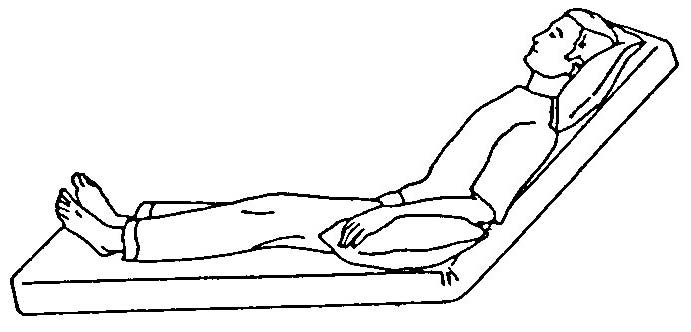 This is the Archived Desktop Edition.
This is the Archived Desktop Edition.
You should be transferred to the Newest Edition for Desktop and Mobile within 2 seconds.
Basic Patient Care Procedures
2-3
2-3. POSITIONING THE PATIENT
Bed rest is an important part of treatment ordered by the medical officer. In addition, the medical officer usually allows a certain amount of physical effort and movement by the patient. If the patient is unable to move himself, he must be moved and repositioned at least every two hours, day and night. If the patient can move himself, he must be encouraged to do so; also, check to see if his posture is good.
a. Orient the Patient. Tell the patient what is to be done, why it is to be done, and how it is to be done. Usually an orientation including the above elicits the full cooperation of the patient.
b. Modification of Bed Rest Positions. Several positions should be used to provide comfort, support, and good body alignment. Sometimes a patient is reluctant to change a position because of a painful disorder; however, failure to change a position may result in deformity of a body part. For example, the continuous use of head and knee rests favor development of a restricted range of joint movement at the hip and knee. An effective preventive position is the front lying (prone) one. In this position, the patient is flat on the abdomen, legs extended, feet over the edge of the mattress, and toes pointing to the floor as illustrated in figure 2-3. Other positions include supine (back lying) (figure 2-4), lateral recumbent (on either side) (figure 2-5), and Fowler's position (semi-upright with back and knee rests elevated) (figure 2-6).
Figure 2-3. Prone position.
Figure 2-4. Supine position.
Figure 2-5. Lateral recumbent.
Figure 2-6. Fowler's position.
(1) Position changes provide alternate weight-bearing surfaces to relieve pressure, improve circulation, and preserve muscle function as different muscle groups contract and relax.
(2) No one position will remain comfortable and safe indefinitely.
c. Body Alignment in Bed. Good body alignment can be achieved in any of the bed rest positions (b above). The following points should be checked.
(1) Head should be in midline with the trunk.
(2) Back should be straight, with normal body curves (cervical, thoracic, and lumbar) maintained.
(3) Ribs should be elevated to prevent constriction of the chest.
(4) Arms and legs should be in a position of function (the position for maximum usefulness of the joints, feet, and hands).
(a) Position of function of legs and feet. This position favors standing upright and walking. In general, if the toes point to the ceiling when in a back-lying position and point to the floor when in a front-lying position, the feet, legs, and hips are in good alignment.
(b) Position of function of arms and hands. This position favors raising the arms and grasping things with the fingers. The hand should not droop at the wrist, be clenched in a fist, or be flat. The position of function for the hand is dorsiflexion (at a slight upward angle) at the wrist, with the fingers and thumb in position to write with a pencil.




